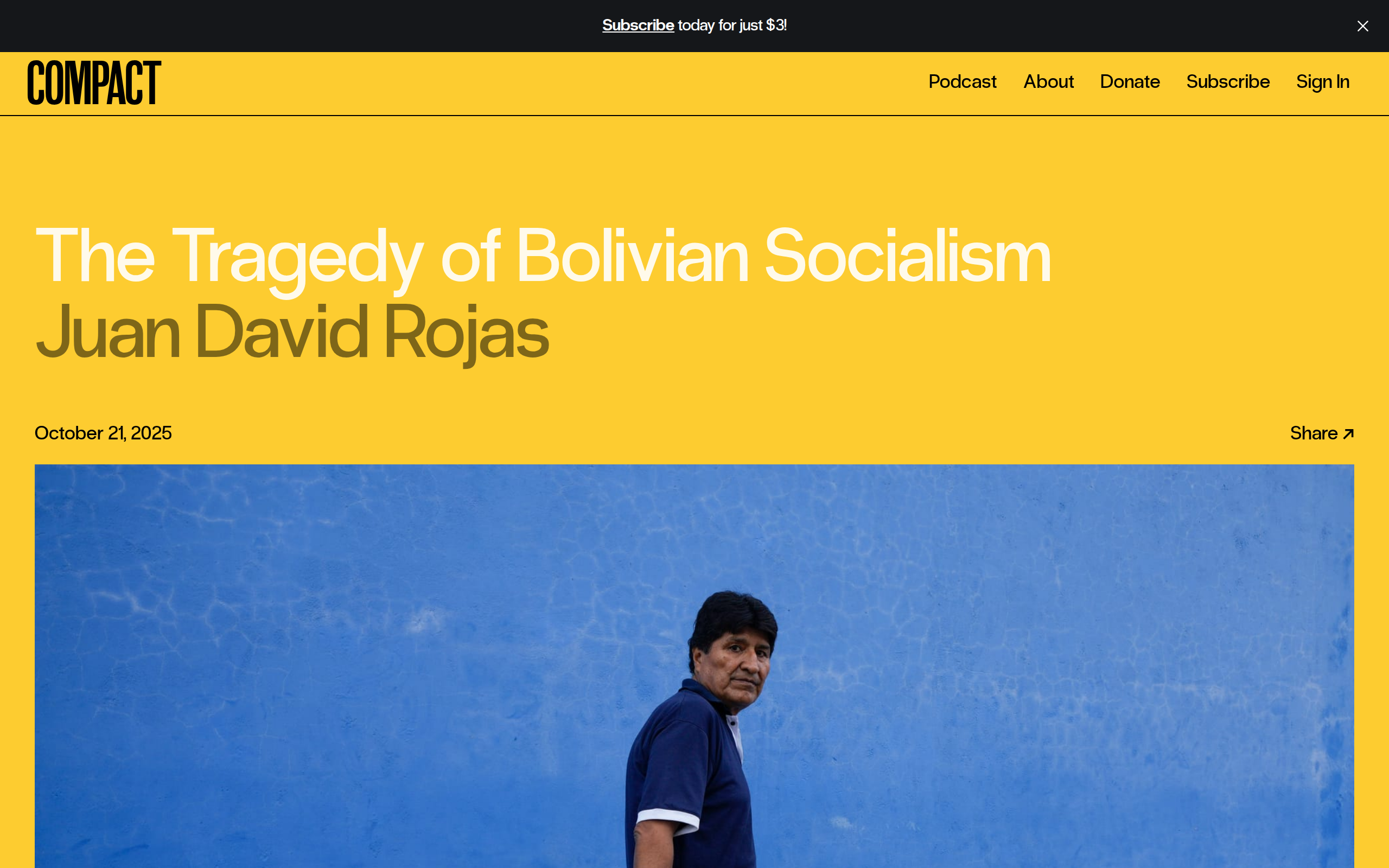On October 19, Bolivians elected Rodrigo Paz Pereira to the presidency. A center-right senator and son of former president Jaime Paz Zamora (1989-1993), Paz ran on a platform of “Capitalism For All,” defeating conservative former president Jorge Quiroga in a run-off. This contest between two right-wing candidates marked a decisive end to almost two decades of political dominance by the leftist Movement Towards Socialism (MAS), formerly led by Evo Morales, who served three presidential terms between 2006 and 2019. In the first round of voting, the MAS candidate for president received just 3 percent of the vote, and the party’s representation in the Chamber of Deputies fell from 75 to one; in the Senate, it went from 21 to zero.
By many measures, MAS was the most successful of all the “pink tide” leftist governments that took power across Latin America during the 2000s. But in recent years, shortages, spiraling inflation, and internal power struggles between Morales and his successor, Luis Arce, led to a collapse in the party’s support. Morales supporters blamed the decisive defeat of the left on the former president’s disqualification, pointing to a high number of blank and spoiled ballots—around 22 percent. But it is unclear whether the megalomaniacal Morales would have made it to the run-off, let alone won the presidency; the top three candidates in the first round were all right-of-center, with the right securing 78 percent of the vote for president and congress.
“MAS’s fall from grace has enabled the return of the same neoliberal regime that preceded it.”
MAS’s fall from grace has enabled the return of the same neoliberal regime that preceded it. What is more, the conditions that led to MAS’s downfall are similar to those that enabled its rise in the first place. Throughout the 1990s and 2000s, inflation in Bolivia hovered between 10 and 20 percent. A series of weak leaders, including both the president-elect’s father and the just defeated Quiroga, presided over a stagnant economy dependent on selling off the country’s resource wealth to foreign multinationals, with hardly any of the proceeds trickling down to the overwhelmingly poor and indigenous majority. Militant popular opposition to this failed economic model led to the alternation of no fewer than five presidents between 2001 and 2005, three of whom resigned—Quiroga among them. The “Gas Wars” that began in 2003 culminated in the 2005 election of the union organizer Evo Morales, the country’s first indigenous president, who campaigned on nationalizing Bolivia’s natural gas reserves.
Morales and MAS used their popular mandate to do exactly that. They also overhauled the Bolivian constitution, creating a plurinational state enshrining the rights, customs, and autonomy of indigenous peoples. Buoyed in equal parts from increased resource rents from state control and the commodities boom of the late 2000s and early 2010s, the government was able to create jobs in state companies and build extensive infrastructure. By 2017, poverty fell from 60 to 33 percent as year-on-year GDP growth exceeded 4 percent; inflation similarly stabilized in the single digits as real wages doubled. The architect of this “Bolivian Miracle” was Arce, the outgoing president, who served as Morales’ economy and finance minister until 2017. At the same time, unlike so many progressives elsewhere, MAS championed the traditional values of its rural, working-class indigenous constituency on topics such as abortion and gender norms.
Internationally, the party was aligned with the Venezuelan-led Bolivarian Alliance for the Americas (ALBA), named after the South American liberator and advocate for Latin American unity, Simon Bolívar. In practice, Bolivarianism served as a forum for Venezuelan soft power over and against US influence in the region. At its height, ALBA consisted of Venezuela, Cuba, Nicaragua, Ecuador, Bolivia, and a host of small Caribbean states. Yet while MAS and especially Morales displayed increasingly autocratic tendencies over time and committed their own share of mistakes, the party adopted an exceptionally responsible stance towards the economy during most of its tenure, in stark contrast with the likes of Hugo Chávez’s Venezuela.
During his 14 years in the presidency, Chávez oversaw a gradual decline in oil production due to a lack of long-term investment in Venezuelan refineries. Morales similarly presided over a decline in natural gas production after 2014 due to a lack of investment in novel gas exploration—a decision that eventually helped bring about MAS’s downfall. But unlike Chávez, who squandered Venezuela’s oil wealth on buying votes and propping up foreign allies, Morales’s government saved a large portion of the revenues that came in during the commodities boom. Between 2006 and 2014, Bolivia’s foreign exchange reserves quintupled to $15 billion; low budget deficits and high economic growth likewise slashed the national debt from 74 to 27 percent of the country’s GDP.
As a result of these prudent fiscal policies, Bolivia avoided the crisis experienced by other left-wing governments in the 2010s, maintaining its gains against poverty in addition to solid economic growth. Over time, however, cracks in the regime’s economic and political foundations showed signs of what was to come. The country’s continued prosperity came entirely at the expense of the central bank’s foreign reserves and increased debt through government stimulus. Morales also became increasingly paranoid, resentful, and megalomaniacal. In a 2015 episode of the Spanish program Salvados, the president claimed that Spanish King Felipe VII glanced at him contemptuously because of his indigenous heritage. When asked about building a statue of himself in his hometown, the Bolivian leader claimed that he was simply giving the people what they wanted.
Like all of his Bolivarian peers, as he approached the constitutional limit of his presidential term, Morales became obsessed with remaining in office indefinitely. Claiming that his first term didn’t count towards the new plurinational constitution’s two-term limit, he turned to voters in the hope that they would allow him to run for a fourth term. In the ensuing 2016 referendum, Bolivians voted decisively against the president’s participation in the 2019 election. Morales, however, chose to run anyway after his cronies on the Supreme Court ruled that he had a “human right” to indefinite reelection. Come election day, the president seemed likely to compete in his first run-off after a strong showing from the centrist Carlos Mesa. The plurinational constitution stipulates that the leading candidate in the first round can win outright without a majority so long as the difference with his nearest opponent exceeds 10 percent. Suspiciously, the vote count was abruptly halted, with the regime citing technical issues.
Protesters took to the streets as the opposition cried foul. When the count resumed, Morales eked out a 10.5 percent lead over Mesa. Demonstrations intensified as police officers were observed ripping the Wiphala—Bolivia’s secondary flag for indigenous peoples—from their uniforms. Finally, the head of Bolivia’s armed forces Williams Kaliman—a longtime ally of the president—suggested that Morales resign, to which he acquiesced. The vice president and MAS leaders of both houses of congress also resigned, leaving a little-known ultraconservative senator, Jeanine Añez as interim president. MAS then denounced this as a coup.
“The Bolivian right let its worst colors show.”
During Añez’s interim rule, which lasted a year, the Bolivian right let its worst colors show. Repression escalated far beyond anything seen under the MAS. An evangelical Christian, Añez sought to reimpose neoliberalism and promote a Christian state free of the “satanic rites” of indigenous “savages.” She also granted immunity to the security forces, which proceeded to slaughter over 30 protestors. Her year in office proved so disastrous, particularly amid the pandemic, that Morales’ hand-picked candidate, Luis Arce, won 55 percent of the vote in the first round of the 2020 election.
After taking office, the new president took immediate action to address the scourge of post-pandemic inflation, and as a result, Bolivia experienced arguably the lowest price increases in the hemisphere, averaging around 2 percent between 2021 and 2023. But the government’s use of subsidies to mitigate supply-related inflation perpetuated the stimulus-dependent economic model that had prevailed in Bolivia since 2014. The effect was to deplete the central bank’s foreign reserves while piling on debt.
However, the most vicious opposition to Arce’s government came not from the country’s unhinged reactionary right, but from Evo Morales, who was evidently disappointed that his erstwhile ally was unwilling to allow his patron to govern in his place. Citing real and imagined deficiencies with Arce’s governance, Morales and his supporters blocked roads throughout the country, compounding Bolivia’s economic woes. In response, the Supreme Court overturned the former president’s “human right” to reelection, while an Arce-aligned judge issued a warrant for Morales’s arrest over his alleged statutory rape of a teenager. None of this was enough to fully discredit Morales within the Bolivian left; he has since taken up residence in a jungle fortress surrounded by armed supporters committed to preventing his arrest.
The toll from the infighting eventually made it impossible to obfuscate what ails the Bolivian economy. After falling to historic lows in 2014, today the debt-to-GDP has skyrocketed to 95 percent; and while gains against poverty have yet to be reversed, they’ve remained stagnant at around 30 percent since 2017. Early in his term, there was hope that the technocratic Arce could turn things around by revitalizing natural gas production and diversifying into lithium production. But shockingly, in 2022 Bolivia became a net importer of fossil fuels due to cratering production and increased domestic demand.
Given the Bolivian right’s dismal track record in office prior to MAS’s rise—not least that of the president-elect’s own father—it’s entirely conceivable that the new administration could worsen the country’s crisis and fail to complete its term. That seems to be Morales’s bet: that the new administration will spontaneously combust, as did Añez’s short-lived administration and the failed neoliberal governments of the early 2000s. This, he hopes, will give him a chance to engineer a comeback, presumably through an ally more pliable than Arce.
Both supporters and detractors must come to terms with the legacy of the MAS and especially Morales. The party and its founder delivered unprecedented gains for workers and dignity for the country’s historically downtrodden indigenous majority. Despite its failings, MAS governed more capably than any of its Bolivarian allies and avoided imitating their descent into rank tyranny. Yet in the end, the party delivered the country on a silver platter back to the same traditional elites it once defeated. It remains to be seen exactly what will follow the tragedy of Bolivian socialism.
First Appeared on
Source link













